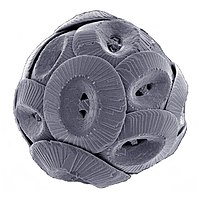
Photo from wikipedia
Mining activities offer clear economic benefits for mineral-rich countries. However, mining operations can produce several environmental impacts. Many of these are associated with generating and managing mining waste known as… Click to show full abstract
Mining activities offer clear economic benefits for mineral-rich countries. However, mining operations can produce several environmental impacts. Many of these are associated with generating and managing mining waste known as tailings, which are typically stored in surface facilities. Windblown dust emissions from tailing deposits can cause severe damage to local ecosystems and adverse health effects for the surrounding population. Microbially induced calcite precipitation (MICP) can be used for the superficial biocementation of tailings, thereby preventing such emissions. This research studied the capacity of MICP for the biocementation of tailings. The effect of applying different doses of biocementation reagents and two different methods for their application were evaluated. Results show that a relevant increase in surface strength can be achieved, especially if reagents are mechanically mixed with the tailings to induce a more homogeneous distribution of precipitates. Micrographical and mineralogical analysis by SEM, FTIR and XRD analysis showed the precipitation of calcium in the form of anorthite, calcite or vaterite. Overall results indicate that calcite precipitation can be induced in tailing by microorganisms with urease activity, providing a potential technique for the biocementation of this material.
Journal Title: Minerals
Year Published: 2023
Link to full text (if available)
Share on Social Media: Sign Up to like & get
recommendations!